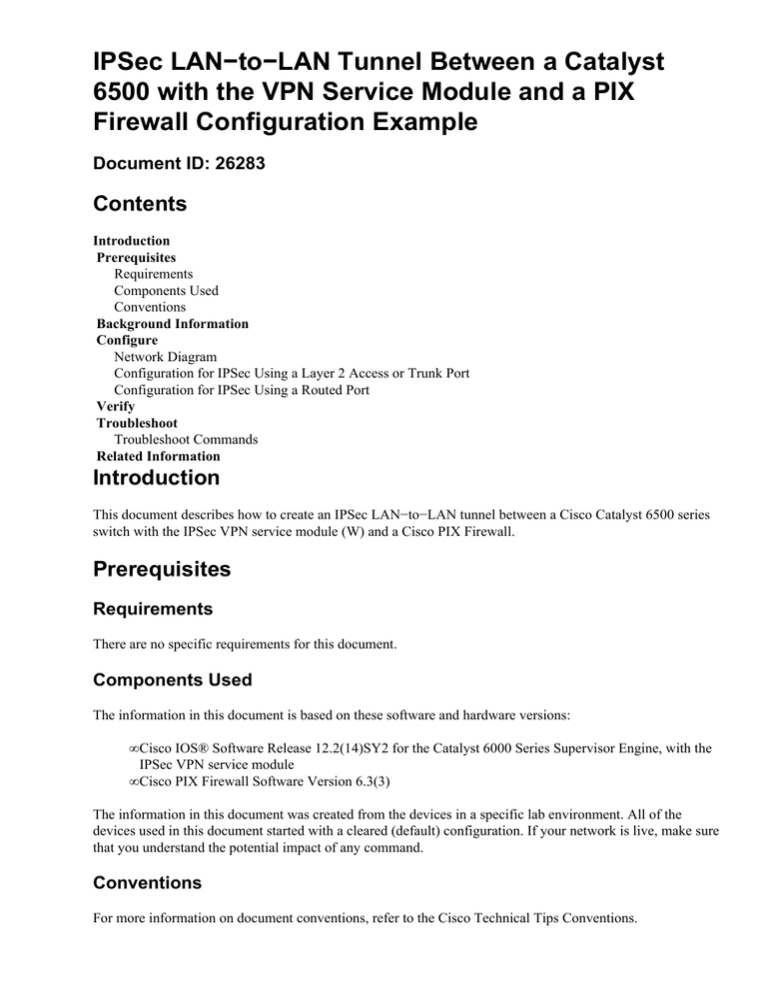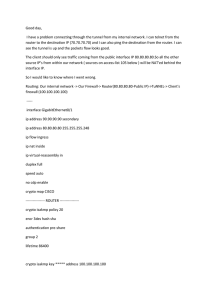
IPSec LAN−to−LAN Tunnel Between a Catalyst
6500 with the VPN Service Module and a PIX
Firewall Configuration Example
Document ID: 26283
Contents
Introduction
Prerequisites
Requirements
Components Used
Conventions
Background Information
Configure
Network Diagram
Configuration for IPSec Using a Layer 2 Access or Trunk Port
Configuration for IPSec Using a Routed Port
Verify
Troubleshoot
Troubleshoot Commands
Related Information
Introduction
This document describes how to create an IPSec LAN−to−LAN tunnel between a Cisco Catalyst 6500 series
switch with the IPSec VPN service module (W) and a Cisco PIX Firewall.
Prerequisites
Requirements
There are no specific requirements for this document.
Components Used
The information in this document is based on these software and hardware versions:
• Cisco IOS® Software Release 12.2(14)SY2 for the Catalyst 6000 Series Supervisor Engine, with the
IPSec VPN service module
• Cisco PIX Firewall Software Version 6.3(3)
The information in this document was created from the devices in a specific lab environment. All of the
devices used in this document started with a cleared (default) configuration. If your network is live, make sure
that you understand the potential impact of any command.
Conventions
For more information on document conventions, refer to the Cisco Technical Tips Conventions.
Background Information
The Catalyst 6500 VPN service module has two Gigabit Ethernet (GE) ports with no externally visible
connectors. These ports are addressable for configuration purposes only. Port 1 is always the inside port. This
port handles all traffic from and to the inside network. The second port (port 2) handles all traffic from and to
the WAN or outside networks. These two ports are always configured in 802.1Q trunking mode. The VPN
service module uses a technique called Bump In The Wire (BITW) for packet flow.
Packets are processed by a pair of VLANs, one Layer 3 inside VLAN and one Layer 2 outside VLAN. The
packets, from the inside to the outside, are routed through a method called Encoded Address Recognition
Logic (EARL) to the inside VLAN. After it encrypts the packets, the VPN service module uses the
corresponding outside VLAN. In the decryption process, the packets from the outside to the inside are bridged
to the VPN service module using the outside VLAN. After the VPN service module decrypts the packet and
maps the VLAN to the corresponding inside VLAN, EARL routes the packet to the appropriate LAN port.
The Layer 3 inside VLAN and the Layer 2 outside VLANs are joined together with the crypto connect vlan
command. There are three types of ports in the Catalyst 6500 series switches:
• Routed portsBy default, all Ethernet ports are routed ports in Cisco IOS. These ports have a hidden
VLAN associated with them.
• Access portsThese ports have an external or VLAN Trunk Protocol (VTP) VLAN associated with
them. You can associate more than one port to a defined VLAN.
• Trunk portsThese ports carry many external or VTP VLANs, on which all packets are encapsulated
with an 802.1Q header.
Configure
In this section, you are presented with the information to configure the features described in this document.
Note: Use the Command Lookup Tool (registered customers only) to find more information on the commands
used in this document.
Network Diagram
This document uses this network setup:
Configuration for IPSec Using a Layer 2 Access or Trunk Port
Perform these steps to configure IPSec with the help of a Layer 2 access or trunk port for the outside physical
interface.
1. Add the inside VLANs to the inside port of the VPN service module.
Assume that the VPN service module is on slot 4. Use VLAN 100 as the inside VLAN and VLAN
209 as the outside VLAN. Configure the VPN service module GE ports like this:
interface GigabitEthernet4/1
no ip address
flowcontrol receive on
flowcontrol send off
switchport
switchport trunk encapsulation dot1q
switchport trunk allowed vlan 1,100,1002−1005
switchport mode trunk
cdp enable
interface GigabitEthernet4/2
no ip address
flowcontrol receive on
flowcontrol send off
switchport
switchport trunk encapsulation dot1q
switchport trunk allowed vlan 1,209,1002−1005
switchport mode trunk
cdp enable
spanning−tree portfast trunk
2. Add the VLAN 100 interface and the interface where the tunnel is terminated (which, in this case, is
interface Vlan 209, as shown here).
interface Vlan100
ip address 10.66.79.180 255.255.255.224
interface Vlan209
no ip address
crypto connect vlan 100
3. Configure the outside physical port as an access or trunk port (in this case, FastEthernet 2/48,
as shown here).
!−−− This is the configuration that uses
an access port.
interface FastEthernet2/48
no ip address
switchport
switchport access vlan 209
switchport mode access
!−−− This is the configuration that uses
a trunk port.
interface FastEthernet2/48
no ip address switchport
switchport trunk encapsulation dot1q
switchport mode trunk
4. Create the Bypass NAT. Add these entries to the no nat statement in order to exempt the nating
between these networks:
access−list inside_nat0_outbound permit ip 192.168.5.0 0.0.0.255
192.168.6.0 0.0.0.255
global (outside) 1 interface
nat (inside) 0 access−list inside_nat0_outbound
nat (inside) 1 192.168.5.0 255.255.255.0
5. Create your crypto configuration and the access control list (ACL) that defines the traffic to be
encrypted.
a. Create a Crypto ACL (in this case, ACL 100 − Interesting Traffic) that defines the traffic
from the inside network 192.168.5.0/24 to the remote network 192.168.6.0/24, like this:
access−list 100 permit ip 192.168.5.0 0.0.0.255 192.168.6.0 0.0.0.255
b. Define your Internet Security Association and Key Management Protocol (ISAKMP) policy
proposals, like this:
crypto isakmp policy 1
hash md5
authentication pre−share
group 2
c. Issue this command (in this example) to use and define pre−shared keys:
crypto isakmp key cisco address 10.66.79.73
d. Define your IPSec proposals, like this:
crypto ipsec transform−set cisco esp−des esp−md5−hmac
e. Create your crypto map statement, like this:
crypto map cisco 10 ipsec−isakmp
set peer 10.66.79.73
set transform−set cisco
match address 100
6. Apply the crypto map to the VLAN 100 interface, like this:
interface vlan100
crypto map cisco
These configurations are used:
• Catalyst 6500
• PIX Firewall
Catalyst 6500
!−−− Define the Phase 1 policy.
crypto isakmp policy 1
hash md5
authentication pre−share
group 2
crypto isakmp key cisco address 10.66.79.73
!
!
!−−− Define the encryption policy for this setup.
crypto ipsec transform−set cisco esp−des esp−md5−hmac
!
!−−−
!−−−
!−−−
!−−−
!−−−
!−−−
Define a static crypto map entry for the peer
with mode ipsec−isakmp.
This indicates that Internet Key Exchange (IKE)
is used to establish the IPSec
security associations (SAs) to protect the traffic
specified by this crypto map entry.
crypto map cisco 10 ipsec−isakmp
set peer 10.66.79.73
set transform−set cisco
match address 100
!
!
no spanning−tree vlan 100
!
!
!
interface FastEthernet2/1
ip address 192.168.5.1 255.255.255.0
!
!−−− This is the outside Layer 2 port that allows
!−−− VLAN 209 traffic to enter.
interface FastEthernet2/48
no ip address
switchport
switchport trunk encapsulation dot1q
switchport mode trunk
!
interface GigabitEthernet4/1
no ip address
flowcontrol receive on
flowcontrol send off
switchport
switchport trunk encapsulation dot1q
!−−− VLAN 100 is defined as the Interface VLAN (IVLAN).
switchport trunk allowed vlan 1,100,1002−1005
switchport mode trunk
cdp enable
!
interface GigabitEthernet4/2
no ip address
flowcontrol receive on
flowcontrol send off
switchport
switchport trunk encapsulation dot1q
!−−−
!−−−
!−−−
!−−−
The Port VLAN (PVLAN) configuration is handled transparently by
the VPN service module without user configuration
or involvement. It also is not shown in the configuration.
Note: For every IVLAN, a corresponding PVLAN exists.
switchport trunk allowed vlan 1,209,1002−1005
switchport mode trunk
cdp enable
spanning−tree portfast trunk
!
interface Vlan1
no ip address
shutdown
!
!−−− This is the IVLAN that is configured to intercept the traffic
!−−− destined to the secure port on which the inside port
!−−− of the VPN service module is the only port present.
interface Vlan100
ip address 10.66.79.180 255.255.255.224
crypto map cisco
!−−−
!−−−
!−−−
!−−−
!−−−
!−−−
This is the secure port that is a virtual Layer 3 interface.
This interface purposely does not have a Layer 3 IP address
configured. This is normal for the BITW process.
The IP address is moved from this interface to the VLAN 100 to
accomplish BITW. This brings the VPN service module into
the packet path.
interface Vlan209
no ip address
crypto connect vlan 100
!
ip classless
global (outside) 1 interface
!−−− NAT 0 prevents NAT for networks specified in the ACL inside_nat0_outbound.
nat (inside) 0 access−list inside_nat0_outbound
nat (inside) 1 192.168.5.0 255.255.255.0
!−−− Configure the routing so that the device
!−−− is directed to reach its destination network.
ip route 0.0.0.0 0.0.0.0 10.66.79.161
!−−− This access list (inside_nat0_outbound) is used with the nat zero command.
!−−− This prevents traffic which matches the access list from undergoing
!−−− network address translation (NAT). The traffic specified by this ACL is
!−−− traffic that is to be encrypted and
!−−− sent across the VPN tunnel. This ACL is intentionally
!−−− the same as (100).
!−−− Two separate access lists should always be used in this configuration.
access−list inside_nat0_outbound permit ip 192.168.5.0 0.0.0.255 192.168.6.0 0.0.0.255
!−−− This is the crypto ACL.
access−list 100 permit ip 192.168.5.0 0.0.0.255 192.168.6.0 0.0.0.255
PIX Firewall
SV2−8(config)# show run
: Saved
:
PIX Version 6.3(3)
interface ethernet0 auto
interface ethernet1 auto
interface ethernet2 auto shutdown
interface ethernet3 auto shutdown
interface ethernet4 auto shutdown
interface ethernet5 auto shutdown
interface ethernet6 auto shutdown
nameif ethernet0 outside security0
nameif ethernet1 inside security100
nameif ethernet2 intf2 security10
nameif ethernet3 intf3 security15
nameif ethernet4 intf4 security20
nameif ethernet5 intf5 security25
nameif ethernet6 intf6 security30
enable password 8Ry2YjIyt7RRXU24 encrypted
passwd 2KFQnbNIdI.2KYOU encrypted
hostname SV2−8
domain−name cisco.com
fixup protocol dns maximum−length 512
fixup protocol ftp 21
fixup protocol h323 h225 1720
fixup protocol h323 ras 1718−1719
fixup protocol http 80
fixup protocol ils 389
fixup protocol rsh 514
fixup protocol rtsp 554
fixup
fixup
fixup
fixup
fixup
fixup
names
protocol
protocol
protocol
protocol
protocol
protocol
sip 5060
sip udp 5060
skinny 2000
smtp 25
sqlnet 1521
tftp 69
!−−− This is the traffic to the router.
access−list 100 permit ip 192.168.6.0 255.255.255.0 192.168.5.0 255.255.255.0
access−list nonat permit ip 192.168.6.0 255.255.255.0 192.168.5.0 255.255.255.0
pager lines 24
mtu outside 1500
mtu inside 1500
mtu intf2 1500
mtu intf3 1500
mtu intf4 1500
mtu intf5 1500
mtu intf6 1500
ip address outside 10.66.79.73 255.255.255.224
ip address inside 192.168.6.1 255.255.255.0
ip address intf2 127.0.0.1 255.255.255.255
no ip address intf3
no ip address intf4
no ip address intf5
no ip address intf6
ip audit info action alarm
ip audit attack action alarm
no failover
failover timeout 0:00:00
failover poll 15
no failover ip address outside
no failover ip address inside
no failover ip address intf2
no failover ip address intf3
no failover ip address intf4
no failover ip address intf5
no failover ip address intf6
pdm history enable
arp timeout 14400
global (outside) 1 interface
nat (inside) 0 access−list nonat
nat (inside) 1 192.168.6.0 255.255.255.0 0 0
route outside 0.0.0.0 0.0.0.0 10.66.79.65 1
timeout xlate 3:00:00
timeout conn 1:00:00 half−closed 0:10:00 udp 0:02:00 rpc 0:10:00 h225 1:00:00
timeout h323 0:05:00 mgcp 0:05:00 sip 0:30:00 sip_media 0:02:00
timeout uauth 0:05:00 absolute
aaa−server TACACS+ protocol tacacs+
aaa−server RADIUS protocol radius
aaa−server LOCAL protocol local
no snmp−server location
no snmp−server contact
snmp−server community public
no snmp−server enable traps
floodguard enable
!−−− These are IPSec policies.
sysopt
crypto
crypto
crypto
crypto
crypto
connection permit−ipsec
ipsec transform−set cisco esp−des esp−md5−hmac
map cisco 10 ipsec−isakmp
map cisco 10 match address 100
map cisco 10 set peer 10.66.79.180
map cisco 10 set transform−set cisco
crypto map cisco interface outside
!−−− These are IKE policies.
isakmp enable outside
isakmp key ******** address 10.66.79.180 netmask 255.255.255.255
isakmp policy 1 authentication pre−share
isakmp policy 1 encryption des
isakmp policy 1 hash md5
isakmp policy 1 group 2
isakmp policy 1 lifetime 86400
telnet timeout 5
ssh timeout 5
console timeout 0
terminal width 80
Cryptochecksum:244c86c9beab00bda8f790502ca74db9
: end
Configuration for IPSec Using a Routed Port
Perform these steps to configure IPSec with the help of a Layer 3 routed port for the outside physical
interface.
1. Add the inside VLANs to the inside port of the VPN service module.
Assume that the VPN service module is on slot 4. Use VLAN 100 as the inside VLAN and VLAN
209 as the outside VLAN. Configure the VPN service module GE ports like this:
interface GigabitEthernet4/1
no ip address
flowcontrol receive on
flowcontrol send off
switchport
switchport trunk encapsulation dot1q
switchport trunk allowed vlan 1,100,1002−1005
switchport mode trunk
cdp enable
interface GigabitEthernet4/2
no ip address
flowcontrol receive on
flowcontrol send off
switchport
switchport trunk encapsulation dot1q
switchport trunk allowed vlan 1,209,1002−1005
switchport mode trunk
cdp enable
spanning−tree portfast trunk
2. Add the VLAN 100 interface and the interface where the tunnel is terminated (which, in this case, is
FastEthernet2/48, as shown here).
interface Vlan100
ip address 10.66.79.180 255.255.255.224
interface FastEthernet2/48
no ip address
crypto connect vlan 100
3. Create the Bypass NAT. Add these entries to the no nat statement in order to exempt the nating
between these networks:
access−list inside_nat0_outbound permit ip 192.168.5.0 0.0.0.255
192.168.6.0 0.0.0.255
global (outside) 1 interface
nat (inside) 0 access−list inside_nat0_outbound
nat (inside) 1 192.168.5.0 255.255.255.0
4. Create your crypto configuration and the ACL that defines the traffic to be encrypted.
a. Create an ACL (in this case, ACL 100) that defines the traffic from the inside network
192.168.5.0/24 to the remote network 192.168.6.0/24, like this:
access−list 100 permit ip 192.168.5.0 0.0.0.255 192.168.6.0 0.0.0.255
b. Define your ISAKMP policy proposals, like this:
crypto isakmp policy 1
hash md5
authentication pre−share
group 2
c. Issue this command (in this example) to use and define pre−shared keys:
crypto isakmp key cisco address 10.66.79.73
d. Define your IPSec proposals, like this:
crypto ipsec transform−set cisco esp−des esp−md5−hmac
e. Create your crypto map statement, like this:
crypto map cisco 10 ipsec−isakmp
set peer 10.66.79.73
set transform−set cisco
match address 100
5. Apply the crypto map to the VLAN 100 interface, like this:
interface vlan100
crypto map cisco
These configurations are used:
• Catalyst 6500
• PIX Firewall
Catalyst 6500
!−−− Define the Phase 1 policy.
crypto isakmp policy 1
hash md5
authentication pre−share
group 2
crypto isakmp key cisco address 10.66.79.73
!
!
!−−− Define the encryption policy for this setup.
crypto ipsec transform−set cisco esp−des esp−md5−hmac
!
!−−−
!−−−
!−−−
!−−−
!−−−
Define a static crypto map entry for the peer
with mode ipsec−isakmp.
This indicates that IKE is used to establish the
IPSec SAs to protect the traffic
specified by this crypto map entry.
crypto map cisco 10 ipsec−isakmp
set peer 10.66.79.73
set transform−set cisco
match address 100
!
!
no spanning−tree vlan 100
!
!
!
interface FastEthernet2/1
ip address 192.168.5.1 255.255.255.0
!
!−−−
!−−−
!−−−
!−−−
!−−−
!−−−
!−−−
This is the secure port that is configured in routed port mode.
This routed port mode does not have a Layer 3 IP address
configured. This is normal for the BITW process.
The IP address is moved from this interface to the VLAN 100 to
accomplish BITW. This brings the VPN service module into
the packet path. This is the Layer 2 port VLAN on which the
outside port of the VPN service module also belongs.
!
interface FastEthernet2/48
no ip address
crypto connect vlan 100
!
interface GigabitEthernet4/1
no ip address
flowcontrol receive on
flowcontrol send off
switchport
switchport trunk encapsulation dot1q
!−−− VLAN 100 is defined as the IVLAN.
switchport trunk allowed vlan 1,100,1002−1005
switchport mode trunk
cdp enable
!
interface GigabitEthernet4/2
no ip address
flowcontrol receive on
flowcontrol send off
switchport
switchport trunk encapsulation dot1q
!−−−
!−−−
!−−−
!−−−
The PVLAN configuration is handled transparently by the
VPN service module without user configuration
or involvement. It also is not shown in the configuration.
Note: For every IVLAN, a corresponding PVLAN exists.
switchport trunk allowed vlan 1,209,1002−1005
switchport mode trunk
cdp enable
spanning−tree portfast trunk
!
interface Vlan1
no ip address
shutdown
!
!−−− This is the IVLAN that is configured to intercept the traffic
!−−− destined to the secure port on which the inside port of the
!−−− VPN service module is the only port present.
interface Vlan100
ip address 10.66.79.180 255.255.255.224
crypto map cisco
!−−−
!−−−
!−−−
!−−−
!−−−
!−−−
This is the secure port that is a virtual Layer 3 interface.
This interface purposely does not have a Layer 3 IP address
configured. This is normal for the BITW process.
The IP address is moved from this interface to the VLAN 100 to
accomplish BITW. This brings the VPN service module into
the packet path.
!
ip classless
global (outside) 1 interface
!−−− NAT 0 prevents NAT for networks specified in the ACL inside_nat0_outbound.
nat (inside) 0 access−list inside_nat0_outbound
nat (inside) 1 192.168.6.0 255.255.255.0
!−−− Configure the routing so that the device
!−−− is directed to reach its destination network.
ip route 0.0.0.0 0.0.0.0 10.66.79.161
!
!−−−
!−−−
!−−−
!−−−
!−−−
!−−−
!−−−
This access list (inside_nat0_outbound) is used with the nat zero command.
This prevents traffic which matches the access list from undergoing
network address translation (NAT). The traffic specified by this ACL is
traffic that is to be encrypted and
sent across the VPN tunnel. This ACL is intentionally
the same as (100).
Two separate access lists should always be used in this configuration.
access−list inside_nat0_outbound permit ip 192.168.5.0 0.0.0.255 192.168.6.0 0.0.0.255
!−−− This is the crypto ACL.
access−list 100 permit ip 192.168.5.0 0.0.0.255 192.168.6.0 0.0.0.255
PIX Firewall
SV2−8(config)# show run
: Saved
:
PIX Version 6.3(3)
interface ethernet0 auto
interface ethernet1 auto
interface ethernet2 auto shutdown
interface ethernet3 auto shutdown
interface ethernet4 auto shutdown
interface ethernet5 auto shutdown
interface ethernet6 auto shutdown
nameif ethernet0 outside security0
nameif ethernet1 inside security100
nameif ethernet2 intf2 security10
nameif ethernet3 intf3 security15
nameif ethernet4 intf4 security20
nameif ethernet5 intf5 security25
nameif ethernet6 intf6 security30
enable password 8Ry2YjIyt7RRXU24 encrypted
passwd 2KFQnbNIdI.2KYOU encrypted
hostname SV2−8
domain−name cisco.com
fixup protocol dns maximum−length 512
fixup protocol ftp 21
fixup protocol h323 h225 1720
fixup protocol h323 ras 1718−1719
fixup protocol http 80
fixup protocol ils 389
fixup protocol rsh 514
fixup protocol rtsp 554
fixup protocol sip 5060
fixup protocol sip udp 5060
fixup protocol skinny 2000
fixup protocol smtp 25
fixup protocol sqlnet 1521
fixup protocol tftp 69
names
!−−−
This is the traffic to the router.
access−list 100 permit ip 192.168.6.0 255.255.255.0 192.168.5.0 255.255.255.0
access−list nonat permit ip 192.168.6.0 255.255.255.0 192.168.5.0 255.255.255.0
pager lines 24
mtu outside 1500
mtu inside 1500
mtu intf2 1500
mtu intf3 1500
mtu intf4 1500
mtu intf5 1500
mtu intf6 1500
ip address outside 10.66.79.73 255.255.255.224
ip address inside 192.168.6.1 255.255.255.0
ip address intf2 127.0.0.1 255.255.255.255
no ip address intf3
no ip address intf4
no ip address intf5
no ip address intf6
ip audit info action alarm
ip audit attack action alarm
no failover
failover timeout 0:00:00
failover poll 15
no failover ip address outside
no failover ip address inside
no failover ip address intf2
no failover ip address intf3
no failover ip address intf4
no failover ip address intf5
no failover ip address intf6
pdm history enable
arp timeout 14400
global (outside) 1 interface
nat (inside) 0 access−list nonat
nat (inside) 1 192.168.6.0 255.255.255.0 0 0
route outside 0.0.0.0 0.0.0.0 10.66.79.65 1
timeout xlate 3:00:00
timeout conn 1:00:00 half−closed 0:10:00 udp 0:02:00 rpc 0:10:00 h225 1:00:00
timeout h323 0:05:00 mgcp 0:05:00 sip 0:30:00 sip_media 0:02:00
timeout uauth 0:05:00 absolute
aaa−server TACACS+ protocol tacacs+
aaa−server RADIUS protocol radius
aaa−server LOCAL protocol local
no snmp−server location
no snmp−server contact
snmp−server community public
no snmp−server enable traps
floodguard enable
!−−−
These are IPSec policies.
sysopt
crypto
crypto
crypto
crypto
crypto
crypto
!−−−
connection permit−ipsec
ipsec transform−set cisco esp−des esp−md5−hmac
map cisco 10 ipsec−isakmp
map cisco 10 match address 100
map cisco 10 set peer 10.66.79.180
map cisco 10 set transform−set cisco
map cisco interface outside
These are IKE policies.
isakmp enable outside
isakmp key ******** address 10.66.79.180 netmask 255.255.255.255
isakmp policy 1 authentication pre−share
isakmp policy 1 encryption des
isakmp policy 1 hash md5
isakmp policy 1 group 2
isakmp policy 1 lifetime 86400
telnet timeout 5
ssh timeout 5
console timeout 0
terminal width 80
Cryptochecksum:244c86c9beab00bda8f790502ca74db9
: end
Verify
This section provides the information to confirm that your configuration works properly.
The Output Interpreter Tool (registered customers only) (OIT) supports certain show commands. Use the OIT
to view an analysis of show command output.
• show crypto ipsec saShows the settings used by the current IPSec SAs.
• show crypto isakmp saShows all current IKE SAs at a peer.
• show crypto vlanShows the VLAN associated with the crypto configuration.
• show crypto eliShows the VPN service module statistics.
For additional information on verifying and troubleshooting IPSec, refer to IP Security Troubleshooting −
Understanding and Using debug Commands.
Troubleshoot
This section provides the information to troubleshoot your configuration.
Troubleshoot Commands
Note: Before you issue debug commands, refer to Important Information on Debug Commands.
• debug crypto ipsecShows the IPSec negotiations of Phase 2.
• debug crypto isakmpShows the ISAKMP negotiations of Phase 1.
• debug crypto engineShows the traffic that is encrypted.
• clear crypto isakmpClears the SAs related to Phase 1.
• clear crypto saClears the SAs related to Phase 2.
For additional information on verifying and troubleshooting IPSec, refer to IP Security Troubleshooting −
Understanding and Using debug Commands.
Related Information
• IPSec Support Page
• Configuring IPSec Network Security
• Configuring Internet Key Exchange Security Protocol
• Technical Support − Cisco Systems
Contacts & Feedback | Help | Site Map
© 2013 − 2014 Cisco Systems, Inc. All rights reserved. Terms & Conditions | Privacy Statement | Cookie Policy | Trademarks of
Cisco Systems, Inc.
Updated: Jan 14, 2008
Document ID: 26283





